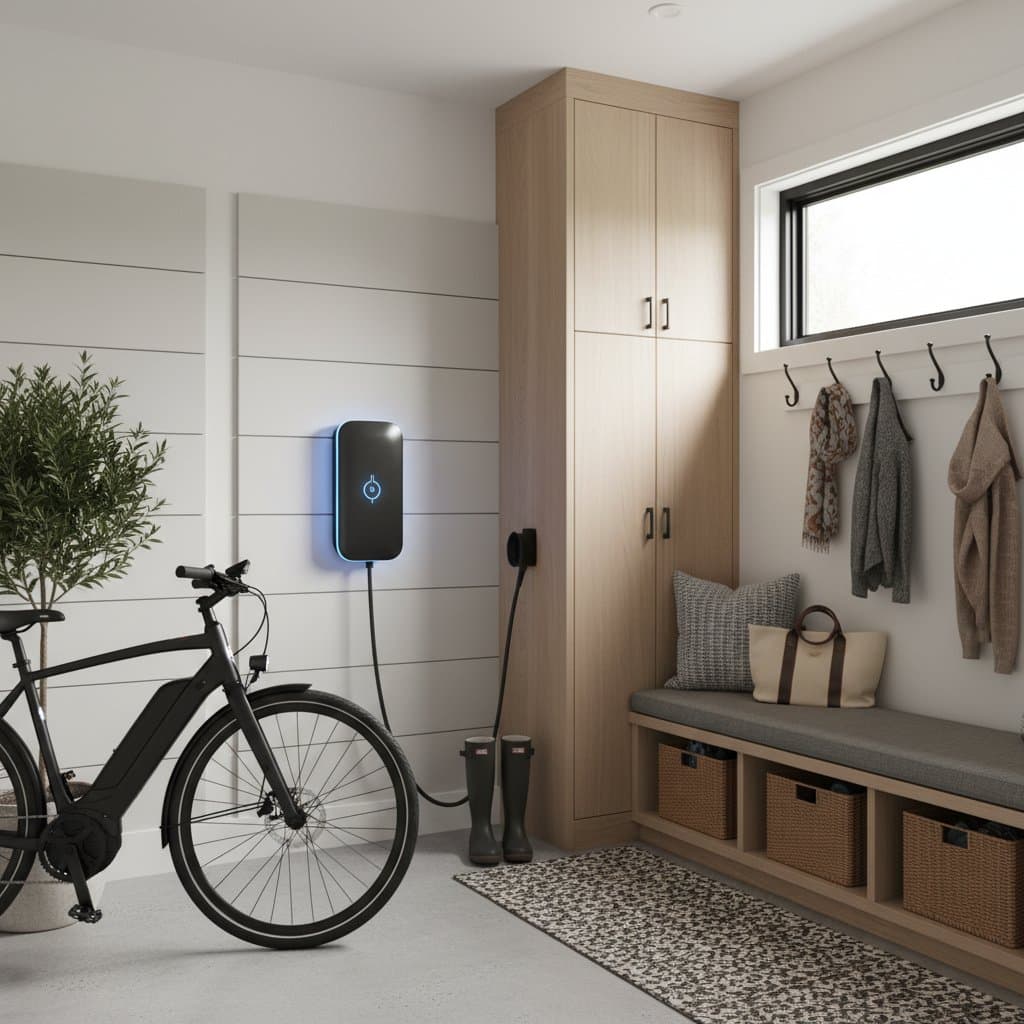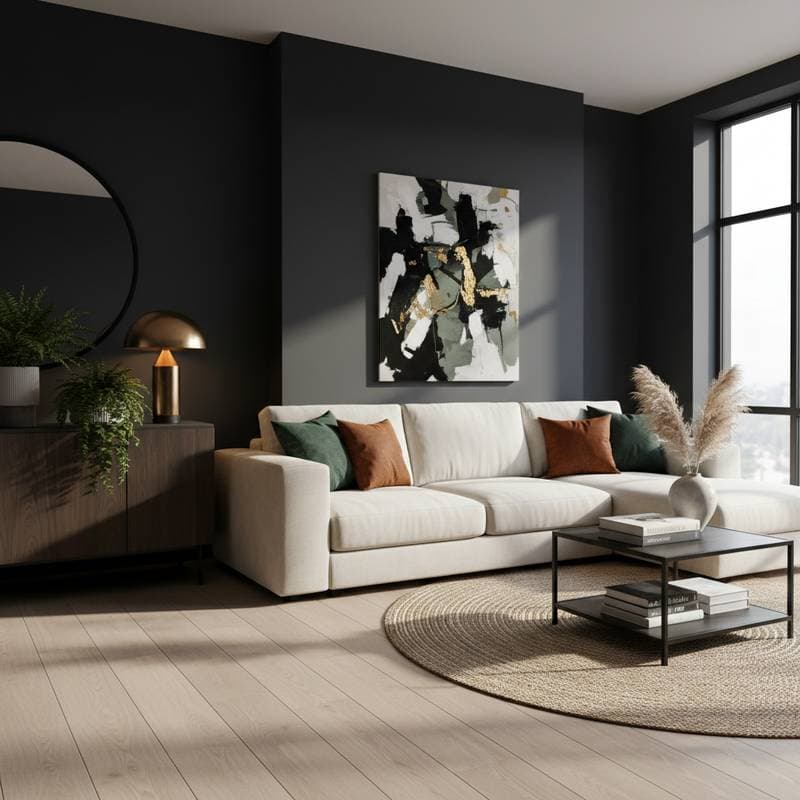Dark Walls: Moody Colors Boost Home Value by 6 Percent
Dark interior paint colors have returned with renewed popularity. Homeowners select deep blues, charcoals, and greens to infuse rooms with warmth and drama. Real estate data indicates that homes featuring dark walls sell for approximately 6 percent more than comparable properties. Sellers benefit from this straightforward update that delivers a quantifiable return, while occupants enjoy a grounded, modern aesthetic.
Understanding Dark Wall Finishes
A dark wall finish employs paint colors from the deeper end of the color spectrum. Examples include navy, graphite, espresso, and forest green. This approach suits homeowners seeking a richer, more layered interior without extensive renovations. It performs effectively in living rooms, bedrooms, and dining areas that receive adequate natural light.
Dark walls provide contrast, visual depth, and a means to accentuate artwork and furniture. They also conceal surface imperfections more effectively than lighter paints.
Cost Overview
The expense of painting dark walls typically ranges from $2 to $6 per square foot, covering labor and materials. For a standard 12-by-14-foot room, professional services cost between $500 and $1,400. DIY efforts reduce this to $150 to $300 for paint and supplies.
High-end projects incorporating premium paints or textured finishes may reach $8 per square foot.
Factors influencing cost include:
- Paint quality and pigment density
- Surface preparation and primer application
- Ceiling height and trim complexity
- Regional labor rates
- Number of coats required for complete coverage
Advantages and Disadvantages
Advantages:
- Establishes a compelling visual impact
- Enhances resale value when combined with contemporary decor
- Masks wall imperfections and scuffs more effectively than light colors
- Transforms large rooms into more intimate settings
- Complements both modern and traditional furnishings
Disadvantages:
- May diminish the perceived size of small or dimly lit spaces
- Reveals dust and fingerprints more readily on matte surfaces
- Poses challenges for touch-ups without noticeable patches
- Often demands additional coats to cover underlying lighter colors
- Necessitates strategic lighting to prevent a gloomy atmosphere
Color and Finish Options
Dark paint finishes vary in tones and sheens, each altering the room's perception.
1. Charcoal Gray
Neutral and versatile, this shade suits offices, bedrooms, and kitchens paired with metal or wood accents.
2. Navy Blue
Timeless and serene, it aligns with coastal, modern, or traditional designs. Brass or natural wood pairings enhance its appeal.
3. Forest Green
Earthy and striking, it brings comfort and depth to living rooms or libraries.
4. Deep Burgundy or Plum
Opulent and theatrical, these colors excel in dining areas or as accent walls.
5. Black or Graphite
Offering high contrast and a sleek modern vibe, they require ample lighting and balanced decor to avoid a confined feel.
Sheen selections:
- Matte: Ideal for imperfect walls but prone to scuffing.
- Eggshell: Provides subtle sheen and simplifies cleaning.
- Satin or Semi-Gloss: Reflects light effectively, suiting trim or high-traffic zones.
DIY Versus Professional Application
Applying dark wall paint demands patience and precision. Uneven coverage often results from hasty work.
DIY Difficulty: Moderate.
Estimated Time: 6 to 10 hours per room.
Essential Tools: High-quality brushes, rollers, painter's tape, primer, drop cloths, and adequate lighting.
Potential Pitfalls: Visible roller marks, inconsistent color distribution, and drips along edges.
Engage professionals for high ceilings or walls requiring repairs. Experts also apply tinted primers for dark colors, ensuring smoother and quicker results.
Application Steps
- Relocate furniture and cover floors with drop cloths.
- Clean walls using mild soap and water to eliminate grease or dust.
- Repair holes and sand irregular areas.
- Apply a tinted primer designed for dark paints.
- Use a quality brush to cut in edges and corners.
- Roll the first coat in sections, preserving a wet edge.
- Allow drying, then add a second coat for uniform depth.
- Examine under strong lighting for streaks or omissions.
- Clean tools and remove tape prior to full paint hardening.
Image: A living room featuring deep navy walls complemented by warm wood trim.
Upkeep and Durability
Dark walls endure with basic maintenance. Clean periodically using a soft cloth or damp sponge. Steer clear of abrasive cleaners that may dull the surface. Store leftover paint in sealed containers for minor touch-ups.
Repainting becomes necessary every 7 to 10 years, influenced by usage and exposure. Certain premium paints include 10-year warranties for color stability. In rentals or for resale preparation, refreshing paint every few years maintains a polished appearance.
Lighter Alternatives
For those hesitant about full dark walls, explore these scaled-back approaches:
1. Accent Wall
Apply a single dark wall behind focal points like a bed or sofa. This draws attention without overwhelming the space.
2. Two-Tone Design
Pair dark lower walls with lighter uppers or wainscoting. The combination preserves equilibrium and introduces personality.
3. Deep Neutrals
Opt for warm taupes, olive greens, or subdued blues. These deliver a moody essence with gentler intensity.
4. Dark-Hued Wallpaper
Select textured or patterned options for added dimension without a monolithic color block.
These methods provide stylistic depth and ambiance with reduced commitment.
Regional Considerations
Local climate and lighting influence dark color performance. In sun-drenched areas, select UV-resistant paints to prevent fading. In overcast or northern locales, dark walls foster a welcoming coziness.
Labor expenses fluctuate significantly. Urban markets with skilled painter shortages often impose 20 to 40 percent premiums. Review local permits or HOA regulations for exterior walls adjacent to communal areas.
Certain municipalities mandate low-VOC or zero-VOC paints to meet air quality standards. Confirm product adherence prior to acquisition.
Return on Investment and Market Impact
Staging analyses reveal that homes with thoughtfully coordinated dark interiors attract buyers more rapidly and command up to 6 percent higher prices. Prospective purchasers perceive these spaces as complete and thoughtfully designed.
Maximize returns by targeting primary living areas, bedrooms, and dining rooms with balanced moody tones. Refrain from darkening every room; incorporate lighter trim or ceilings for spatial dimension.
This enhancement yields an excellent cost-benefit profile. An investment of several hundred dollars in paint can generate thousands in elevated sale proceeds.
Safety Guidelines
Painting involves minimal hazards when precautions are observed:
- Ensure room ventilation through open windows and fans.
- Don a mask during sanding or primer application.
- Store paint distant from open flames or pilot lights.
- Position ladders on stable surfaces.
- Dispose of excess paint at designated recycling facilities.
For oil-based paints, use metal containers for storage and limit indoor application around children or pets.
Expert Recommendations
- Apply sample swatches to various walls before purchasing full quantities. Observe how colors evolve under different lighting.
- Employ gray-tinted primer to optimize coverage and conserve paint.
- Paint trim after walls to facilitate precise edge cleanup.
- Integrate layered lighting, such as floor and table lamps, to mitigate shadows.
- Balance dark tones with airy, natural decor elements.
These strategies prevent heaviness while amplifying the bold character of dark walls.
Frequently Asked Questions
Do dark walls reduce a room's apparent size?
They may in spaces with limited natural light. Incorporate mirrors and pale furniture to sustain openness.
Which finish suits dark colors most effectively?
Eggshell or satin offers depth with controlled reflectivity. Matte provides elegance yet wears quicker from scuffs.
Achieving Lasting Value Through Dark Walls
Implementing dark walls elevates both daily living and property worth. Select shades that harmonize with your environment and lighting conditions. This strategic choice not only modernizes interiors but also positions homes favorably in competitive markets, ensuring enduring appeal and financial gain.








